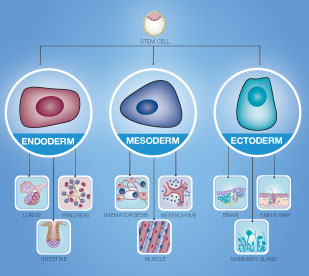
| Catalog No | Select Antibodies |
|---|
Stem Cells
Stem cells are defined as undifferentiated biological cells that can further differentiate into specialized cells. There are two types of stem cells: embryonic stem cells isolated from the inner cell mass of blastocysts and adult stem cells found in various tissues. In adult organisms, stem cells and progenitor cells serve as a repair system for the body. There are a number of sources for adult stem cells in humans: bone marrow, adipose tissue and blood. In a developing embryo, stem cells can differentiate into various specialized cells derived from the ectoderm, endoderm and mesoderm (1).
Stem cells possess two main properties: self-renewal (the ability to go through numerous cycles of cell division while maintaining the undifferentiated state) and potency (the capacity to differentiate into specialized cell types) (2).
Embryonic stem cell lines are cultured from the inner cell mass of a blastocyst, an early stage embryo. Human ES cells have to be cultured on a feeder layer of mouse embryonic fibroblasts and require the presence of basic fibroblast growth factor (bFGF or FGF-2) (3). Human ES cells are also defined by the expression of several transcription factors and cell surface proteins. The transcription factors Oct-4, Nanog, and Sox2 form the main regulatory network that ensures the suppression of genes that lead to differentiation and the maintenance of pluripotency (4). The cell surface antigens most commonly used to identify hES cells are the glycolipids stage specific embryonic antigen 3 and 4 and the keratin sulfate antigens Tra-1-60 and Tra-1-81.
Bone marrow is known to be one of the sources of adult stem cells and has been used to treat several conditions such as leukemia and related bone/blood cancers (5). In addition, recent scientific advancements have shown that adult stem cells can be reprogrammed to give rise to pluripotent capabilities using protein transcription factors. Scientists applied a set of transcription factors Oct3/4, Sox2, c-Myc, Nanog, Lin28 and Klf4 in their experiments on human adult cells (6,7).
Pluripotency and self-renewal are regulated by a number of cell signaling pathways such as TGF-β, which signals through Smad2/3/4 and FGFR, activating MAPK and Akt pathways. The Wnt pathway promotes pluripotency through a non-canonical mechanism involving the transcriptional activator TCF1 and the repressor TCF3. Signaling through these pathways results in the activation of three key transcription factors: Oct-4, Sox2, and Nanog.
Abcepta offers high-quality, in-house developed antibodies for the elucidation of signaling pathways in stem cell research. In addition, Abcepta developed antibodies for the study of mechanisms important for stem cell therapy in human diseases including cancer, neurodegenerative disorders and other pathologies.
References
1)
Sasai Y. (2013) Cell Stem Cell 12: 520-530.
2)
Mitalipov S. and Wolf D.(2009) Adv Biochem Eng Biotechnol.114: 185–199.
3)
Ulloa-Montoya F, Verfaillie CM and Hu WS. (2005) J Biosci Bioeng.100(1):12-27.
4)
Boyer LA, Lee TI, Cole MF, Johnstone SE, Levine SS, Zucker JP, Guenther MG, Kumar RM, Murray HL, Jenner RG, Gifford DK, Melton DA, Jaenisch R and Young RA.(2005) Cell122(6):947-56.
5)
Gahrton G and Björkstrand B.(2000). J Intern Med. 248(3):185-201.
6)
Takahashi K, Tanabe K, Ohnuki M, Narita M, Ichisaka T, Tomoda K and Yamanaka S.(2007) Cell 131(5):861-72.
7)
Yu J, Vodyanik MA, Smuga-Otto K, Antosiewicz-Bourget J, Frane JL, Tian S, Nie J, Jonsdottir GA, Ruotti V, Stewart R, Slukvin II and Thomson JA. (2007) Science. 318(5858):1917-20.














 Foundational characteristics of cancer include proliferation, angiogenesis, migration, evasion of apoptosis, and cellular immortality. Find key markers for these cellular processes and antibodies to detect them.
Foundational characteristics of cancer include proliferation, angiogenesis, migration, evasion of apoptosis, and cellular immortality. Find key markers for these cellular processes and antibodies to detect them. The SUMOplot™ Analysis Program predicts and scores sumoylation sites in your protein. SUMOylation is a post-translational modification involved in various cellular processes, such as nuclear-cytosolic transport, transcriptional regulation, apoptosis, protein stability, response to stress, and progression through the cell cycle.
The SUMOplot™ Analysis Program predicts and scores sumoylation sites in your protein. SUMOylation is a post-translational modification involved in various cellular processes, such as nuclear-cytosolic transport, transcriptional regulation, apoptosis, protein stability, response to stress, and progression through the cell cycle. The Autophagy Receptor Motif Plotter predicts and scores autophagy receptor binding sites in your protein. Identifying proteins connected to this pathway is critical to understanding the role of autophagy in physiological as well as pathological processes such as development, differentiation, neurodegenerative diseases, stress, infection, and cancer.
The Autophagy Receptor Motif Plotter predicts and scores autophagy receptor binding sites in your protein. Identifying proteins connected to this pathway is critical to understanding the role of autophagy in physiological as well as pathological processes such as development, differentiation, neurodegenerative diseases, stress, infection, and cancer. Klf4
Klf4 Oct4
Oct4 Lin28
Lin28 Sox2
Sox2 Sox2
Sox2 Nestin
Nestin